
Installation and commissioning
5.4 CPLUG (configuration plug)
CP 443-1 Advanced (GX30)
Manual, 03/2019, C79000-G8976-C256-05
61
Figure 5-2
Inserting a C-PLUG
Removing the C-PLUG
Remove the C-PLUG from the compartment using a screwdriver.
Figure 5-3
Removing the C-PLUG
It is only necessary to remove the C-PLUG if a fault occurs on the CP.
Function
If the C-PLUG has not been written to (factory status), when the device starts up all
configuration data of the CP is automatically backed up.
A basic device with an inserted C-PLUG automatically uses the configuration data of the
inserted C-PLUG when it starts up. This is, however, only possible when the data was
written by a compatible device type.
This allows fast and simple replacement of the basic device. If a device is replaced, the C-
PLUG is taken from the failed component and inserted in the replacement. As soon as it
starts up, the replacement automatically has the same device configuration as the failed
device.
Using a CPLUG with old configuration data
Use only C-PLUGs that are formatted for the CP 443-1 Advanced. CPLUGs that have
already been used and formatted in other device types must first be formatted for the CP
4431 Advanced.
You do this with STEP 7 / special diagnostics. For more detailed information, refer to the
online help in the topic "General Diagnostics Functions - C-PLUG Diagnostics Object".
After formatting, all data areas are deleted on the C-PLUG. The configuration data is
adopted by the CPU only after reloading or after turning on the power supply again.
















































